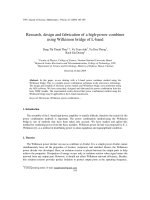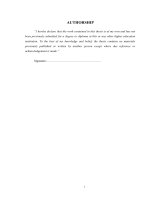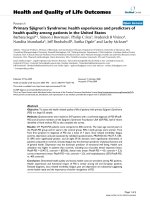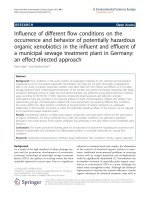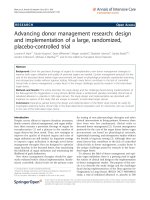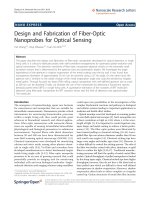RESEARCH, DESIGN AND FABRICATION OF DIGITAL INFORMATION TRANSIMITER WORKING IN THE VHF BAND
Bạn đang xem bản rút gọn của tài liệu. Xem và tải ngay bản đầy đủ của tài liệu tại đây (1.9 MB, 47 trang )
AUTHORSHIP
“I hereby declare that the work contained in this thesis is of my own and has not
been previously submitted for a degree or diploma at this or any other higher education
institution. To the best of my knowledge and belief, the thesis contains no materials
previously published or written by another person except where due reference or
acknowledgement is made.”
Signature:………………………………………………
1
SUPERVISOR’S APPROVAL
“I hereby approve that the thesis in its current form is ready for committee
examination as a requirement for the Bachelor of Computer Science degree at the
University of Engineering and Technology.”
Signature……………………………………………………………
2
ACKNOWLEGEMENT
Foremost, I would like to express my deep and sincere gratitude to my supervisor
professor. Bach Gia Duong for his continuous support of dissertation, for his motivation,
enthusiasm and immense knowledge. His guidance has been of great value for me in all the
time of researching and writing of my thesis.
My heartily thanks are due to Master. Hoang Duc Long at the Research Center of
Electronics and Telecommunications for his invaluable help during the time I worked in
the laboratory.
I would like to give my heartfelt thanks to all professors in University of
Engineering and Technology for their basic knowledge and dedicated guidance.
Last but not the least, I owe my loving thanks to my family and my dear friends
who always encourage and being along with me.
Sincerely,
Van-The Nguyen
3
ABSTRACT
Currently high frequency technique is widely used in the field of communication.
The wireless communications services are increasing powerful. The deployment of these
types of communications in very high frequency band has become inevitable and essential.
Especially boom in broadband communications to promote the exploitation of parallel
frequency channels in high frequency range that allow maximum usability bandwidth.
Communications in high frequency bands have advantages in complex environments,
especially where high-frequency waves transmitted directly between two parallel points of
contact and communication through the ionosphere, in outer space In Vietnam,
information transceiver system working VHF bands have a lot of important applications.
Therefore, the study of information transceiver systems in the band VHF to understand the
structure, the transmission characteristics in order to master the technology to go to
complete the set and apply the product on the fact that the purpose end of the study. In the
framework of this thesis, I have completed the following tasks:
-Study about the structure of transmitter system.
-Study carefully VCO block in the transmitter system.
-Study about delta modulation.
-Design and fabricate successfully VCO circuit in VHF band and delta modulate
circuit.
4
TABLE OF CONTENTS
5
List of Figures
6
List of Table
7
ABBREVATIONS
BJT Bipolar Junction Transistor
CB Common Base
CC Common Collector
CE Common Emitter
EB Emitter-Base
FM Frequency Modulation
IF Intermediate Frequency
KVL Kirchoff Voltage Law
LNA Low Noise Amplifier
UHF Ultra High Frequency
VHF Very High Frquency
Chapter 1
INTRODUCTION
1.1,Overview of VHF frequency band
Very high frequency(VHF) is the ITU-designated range of radio frequency
electromagnetic waves from 30 MHz to 300 MHz,with corresponding wavelengths of one
8
to ten meters.Common uses for VHF are FM radio broadcasting ,television
broadcasting,land mobile stations,long range data communication up to several tens of
kilometres with radio modems,amateur radio, and marine communications.Air traffic
control communication and air navigation systems work at distances of 100 kilometres or
more to aircraft at cruising altitude.
1.2 Propagation characteristics
VHF propagation characteristics are ideal for short distance terrestrical
communication,with a range generally somewhat farther than line of sight from the
transmitter.Unlike high frequency(HF),the ionosphere does no usually reflect VHF waves
so transmissions are restricted to the local radio horizon less than 100 miles.VHF is also
less affected by atmospheric noise and interference from electrical equiqment than lower
frequencies.While it is blocked by land features such as hills and mountains,it is less
affected by buildings and can be received indoors,although multipath television reception
due to reflection from buildings can be a problem in urban areas.
1.3 Thesis objectives and structure.
In this thesis,I will clarify the roles and the need of a information digital transmitter
in VHF band. Study the function of each block in a transmitter system and especially a
VCO block will be studied.Study about delta modulation. Finally, the experience is design,
fabricate a VCO and delta modulation using FX609J.This thesis is organized in five
sections:
-Chapter 1:Provide an overview of VHF frequency band,propagation characteristic
and objectives and structure of this thesis.
-Chapter 2: Study in detail about VHF transceiver system and VCO block.
-Chapter 3:Modulation delta signal.
-Chapter 4: Design, Fabrication a VCO circuit,delta modulation circuit and
achievement results.
-Chapter 5: Summarization what have been done in the thesis.
9
10
Chapter 2
THE STRUCTURE OF TRANSMITTER
2.1Blog diagram of transmitter
Figure 2.1 Blog diagram of transmitter system
2.1.1 Function of modules in the system
Processing signal Receive signal
Adding two input signals to produce a micro
wave signal.
A driver amplifier can be simply considered as
11
Upconversion
a driver (to amplify power) that is capable of
providing sufficient current (power) to drive the
following stage of the circuit.
The maximum output power at transmitters is
1W. with the assumption 2 antennas in the light
of sigh the transmission distance can be 10km
A voltage-controlled oscillator or VCO is an
electronic oscillator whose oscillation frequency
is controlled by a voltage input. The applied
input voltage determines the instantaneous
oscillation frequency
Low-noise amplifier (LNA) is an amplifier
which located very close to the receiver to
reduce losses in the feed line. Its main function
is amplifying the weak signal at the receiver
with suitable gain and adding very little noise.
The nature of downconversion is the same with
upconversion, the difference is input signal and
the position in system. If the upconversion be
used in transmitter, downconversion is inversely
at the receiver. The microwave signal go
through this block will turn into intermediate
signal IF carry the information
Accepts the intermediate frequency signal from
the converter, amplify and pass signal on to
either, the next stage (if the receiver has one), or
to the detector stage.
Detect the desire signal
12
The function of an audio amplifier is to amplify
signal without making any other changes in it
before playing in the speaker.
Speaker: used to play the sound.
Antenna: transmit or receive signal.
Table 2.1 Block’function
2.2 Voltage-controlled oscillator
A voltage-controlled oscillator or VCO is an electronic oscillator whose oscillation
frequency is controlled by a voltage input.The applied input voltage determines the
instantaneous oscillator frequency.Consequently,modulating signals applied to control
input may cause frequency modulation (FM) or phase modulation (PM).A VCO may also
be part of phase-locked loop.
*The basic parameter of oscillator
+ Resonant frequency
+ The amplitude of the output voltage
+ The stability of output frequency
+Output power
+ Circuit performance
*The output signal can be created by two principles
+Using amplifier circuit with positive feedback
+Using circuit analysis method
*A good oscillator circuit has to satisfy
+Condition of amplitude stability
+Condition of phase stability
13
Figure 2.2 Diagram system
The rate of output to input voltage:
s
S
in
out
H
H
V
V
+
=
1
(1)
The signals go through the amplifier; the output signal has out-phased with the
input signal.
After receiving the feedback, 2 synchronic signals will continue to be amplifying
until the coefficient gain large enough to be self-excitation.
Figure 2.3 Diagram of operating circuit showing signal in time domain.
Figure 2.4 Diagram of feedback circuit
The gain:
K
β
=
β
.1 K
K
−
(2)
Where K is gain number of amplifier device, β is the complex transfer function of
the feedback circuit; K
β
is the gain of feedback amplifier circuit.
So the Barkhausen stability criterion has to satisfy:
Kβ =
)
k
(j
eK
β
ϕ+ϕ
β
= 1
(3)
When
K
β
= ∞
the circuit will oscillates.
The equation above can be written more detail:
β
K
= 1; ϕ
K
+ ϕ
β
= 2Kπ
(4)
14
These two equations are Amplitude stability condition and Phase stability
condition.
2.3 Three-point oscillator
Figure 2.5 Diagram of general 3-point circuit oscillators
Oscillator circuit LC has 3 common points between resonant tank and the circuit so
we call it is 3-point circuit oscillators. The positive feedback is implemented through the
inductor or capacitor. First, we consider the general principle as the diagram in Figure 2.5
Where Z
1
, Z
2
, Z
3
are the element of the serial resonant circuit system with:
Z
1
= r
1
+ jX
1
Z
2
= r
2
+ jX
2
Z
3
= r
3
+ jX
3
r
i
– is the loss of Z
i
, X
i
can be negative or positive depend on Z
i
and always satisfy:
r
i
<< X
i
(5)
Gain of circuit: K = - S. Z
t
(6)
Z
t
is load resistance of amplifier circuit:
Z
t
≈ Z
3
// (Z
1
+ Z
2
) = Z
3
=
( )
Z Z Z
Z Z Z
3 1 2
1 2 3
+
+ +
(7)
Transfer coefficient of the feedback circuit:
21
2
ra
ht
ZZ
Z
U
U
+
≈=β
(8)
Condition (3) will be:
( )
( )
1
ZZZ
ZZ
ZZ
Z
ZZZ
ZZZ
K
321
32
21
2
321
213
=
++
−=
+++
+
−=β
.
)(
(9)
Combine with (5) we obtain:
15
1
XXXjrrr
XX
SK
321321
32
=
+++++
≈β
)(
(10)
So:
X
1
+X
2
+X
3
= 0 (11)
1
rrr
XSX
321
32
=
++
(12)
(11) and (12) correspond with the condition of Phase stability and Amplitude
stability. From (11) infer X
2
and X
3
must have the same characteristic (Capacitance or
Inductance). Combine with (11) so X
1
is opposite sign with X
2
and X
3
.
2.4 Capacitive three-point circuit
Figure 2.6 Capacitive three-point oscillator circuit
In Capacitive three-point circuit, we have X
1
= X
CB
= ωL > 0
X
2
= X
BE
=
0<
ω
1
−
2
C
(13)
X
3
= X
CE
=
0<
ω
1
−
1
C
(14)
Feedback number :
β = -
C
C
1
2
= - n
(15)
16
17
Gain number:
K = - g
21e
Zt
c h
= -
2
11
2
11
21
n
h
//Rtdp
h
h
e
e
e
(16)
h
n
e11
2
- input resistance of transistor to resonant tank.
The condition (3) becomes:
(1+n
2
)h
11e
+ n
2
R
tđ
- nR
tđ
h
21e
≤ 0
(17)
In the expression the mark " < “corresponding with the transient period (when Kβ >
1) the mark " = “match with the steady state which the oscillator be established.
Normally n << 1 so (17) has the form:
0≤1+−
11
21
11
2
td
td
R
eh
eh
n
eh
R
n
(18)
Solve (18) with the mark "=" two value of n is n
1
and n
2
be found:
Rtd
h
hh
n
ee
,
11
2
2121
21
−
2
±
2
=
(19)
The value of n in the range of: n
2
< n < n
1
with this condition the circuit will
oscillate.
When the oscillation is established n will receive the value of n
1
or n
2
The resonant frequency will be:
f
d đ
= f
Ch
=
21
21
+
π2
1
CC
CC
L
(20)
The operating frequency of circuit:
18
ω
2
L=[1/(C
2
+C
var
)]+(1/C
3
)+(1/C
4
)
Figure 2.7 a. VCO Colpitts parallel tuning
19
Chapter 3
CONTINUOUSLY VARIABLE SLOPE
DELTA MODULATION
3.1 General
The continuously variable slope delta(CVSD) modulation is a nonlinear,sampled
data,feedback system which accepts a band-limited analog signal and encodes it into
binary form for transmission through a digital channel.At the receiver,the binary signal is
decoded into a close approximation of the original analog signalA typical CVSD converter
consisting of an encoder and decoder is show in Figure3.1,Figure3.2.
Figure 3.1 Typical CVSD encoder
Figure 3.2 Typical CVSD decoder
20
3.2 General descriptions
3.2.1 Delta Modulation
Delta modulation is an A-D conversion technique resulting in a form of digital
pulse modulation .A delta modulator periodically samples the amplitude of a band-limited
analog sinal and the amplitude differences of two adjacent samples are coded into n bit
code words.This nonlinear,sampled-data feedback system then transmits the encoded bit
stream through a digital channel.At the receiver end ,an integrating network converts the
delta-modulated bit stream through a decoding process into a close approximation of the
orginal analog signal.
3.2.2 CVSD Converter
A typical CVSD converter consists of an encoder and a decoder(see Figure 3.1 and
Figure 3.2).The analog input signal of the CVSD encoder is band-limited by the input
band,pass filter.The CVSD encoder compares the band-limited analog input signal with an
analog feedback approximation signal generated at the reconstruction integrator output.The
digital output signal of the encoder is the output of the first register in the counter.the
digital output signal is transmitted at the clock(sample) rate and will equal”1” if the analog
input signal is greater than or equal to the analog feedback signal at the instant of the
sampling.For this value of the digital output signal,the pulse amplitude modulator(PAM)
amplies a positive feedback pulse to the reconstruction integrator;otherwise a negative
pulse is applied.This function is accomplished by the polarity control signal,which is equal
to the digital encoder output signal.the amplitude of the feedback pulse is derived by
means of a 3 bit shift register,logic sending for overload and a syllabic lowpass filter.When
a string of three consecutive ones ar zeros appears at the digital output ,a discrete voltage
level is applied to the syllabic filter,and the positive feedback pulse amplitude increases
until the overload string is broken.In such an event,ground potential is fed to the filter by
the overload algorithm,forcing a decrease in the amplitude of the slopevoltage out of the
syllabic filter.the encoder and decoder have identical characteristics except for the
comparator and filter functions.
The CVSD decoder consists of the input band pass filter, shift register, overload
algorithm, syllabic filter, PAM and reconstruction integrator used in the encoder, and an
output low-pass filter. The decoder performs the inverse function of the encoder and
regenerates speech by passing the analog output signal of the reconstruction integrator
21
through the low-pass filter. Other characteristics optimize the CVSD modulation technique
for voice signals. These characteristics include the following.
+ Changes in the slope of the analog input signal determine the step-size changes of
the digital output signal.
+ The feedback loop is adaptive to the extent that the loop provides continuous or
smoothly incremental changes in step size.
+ Companding is performed at a syllabic rate to extend the dynamic range of the
analog input signal.
+ The reconstruction integrator is of the exponential (leaky) type to reduce the
effects of digital errors.
3.3.Detailed descriptions
3.3.1 Input Band Pass Filter
The input filter provides band-limiting and is typically a second- or higher-order
filter
3.3.2 Comparator
The comparator compares the band-limited analog input signal from the filter with
the output signal of the reconstruction integrator. This comparison produces the digital
error signal input to the 3-bit shift register. The transfer characteristic of the comparator is
such that the difference between the two input signals causes the output signal to be driven
to saturation in the direction of the sign of the difference.
3.3.3 Bit Shift Register
The 3-bit shift register acts as a sampler which clocks the digital error signal from
the comparator at the specified data signaling rate and stores the current samples and two
previous samples of the error signal. The digital output signal is a binary signal having the
same polarity as the input signal from the comparator at the time of the clock signal. The
digital output signal is also the digital output of the encoder and is referred to as the
baseband signal. Further processing for transmission such as conditioned diphase
modulation may be applied to the baseband signal. It is necessary that the inverse of any
such processing be accomplished and the baseband signal restored before the CVSD
decoding process is attempted.
22
3.3.4 Overload Algorithm
The overload algorithm operates on the output of the 3-bit shift register (X, Y, Z)
using the run-of-three coincidence algorithm. The output signal is a binary signal at the
clock signaling rate and is true for one clock period following the detection of three like
bits and false at all other times.
3.3.5 Syllabic Filter
The syllabic filter acts as a low-pass filter for the output signal from the overload
algorithm. The slope-voltage output of the syllabic filter is the modulating input to the
PAM. The step-function response of the syllabic filter is related to the syllabic rate of
speech, is independent of the sampling rate, and is exponential in nature. When the
overload algorithm output is true, a charging curve is applicable. When this output is false,
a discharging curve is applicable.
3.3.6 Pulse Amplitude Modulator
The PAM operates with two input signals: the output signal from the syllabic filter
and the digital signal from the 3-bit shift register. The syllabic filter output signal
determines the amplitude of the PAM output signal and the signal from the 3-bit shift
register is the polarity control that determines the direction, plus or minus, of the PAM
output signal. The phrase “continuously variable” in CVSD is derived from the way the
PAM output signal varies almost continuously.
3.3.7 Reconstruction Integrator
The reconstruction integrator operates on the output signal of the PAM to produce
an analog feedback signal to the comparator (or an output signal to the output low-pass
filter in the receiver) that is an approximation of the analog input signal.
3.3.8 Output Low-Pass Filter
The output filter is a low-pass filter having a frequency response that typically has
an asymptotic rolloff with a minimum slope of 40 decibels (dB) per octave, and a stopband
rejection that is 45 dB or greater. The same output filter characteristic is used for encoder
digital output signals of either 16 or 32 kilobits per second (kbps).
3.3.9 Typical CVSD Decoder Output Envelope Characteristics
For a resistance/capacitance circuit in the syllabic filter with time constants of 5
microseconds (ms) for both charging and discharging, the envelope characteristics of the
signal at the decoder output are shown in Figure 3.3. For the case of switching the signal at
23
the decoder input from the 0 percent run-of-threes digital pattern to the 30 percent run-of-
three digital pattern, the characteristic of the decoder output signal follows the
resistance/capacitance charge curve. Note that the number of time constants required to
reach the 90 percent charge point is 2.3, which gives a nominal charge time of 11.5 ms
Figure 3.3 Typical Envelope Characteristics of the Decoder Output Signal for CVSD
When switching the other way (from the 30 percent pattern to the 0 percent
pattern), the amplitude at the beginning of discharging is, at the first moment of switching,
higher (by a factor of 16) than the final value which is reached asymptotically. The final
value equals -24 dBm0, that is, 0.03. Therefore, the amplitude at the beginning of
discharging is 0.48 (percent run-of- threes = 0). Note that the number of time constants
required to reach the 10 percent point on the discharge curve is 1.57, which gives a
nominal discharge time of 7.8 ms.
3.4 Reference Level
The decoder analog output level with the 16 and 32 kbps, 30 percent run-of-threes
reference digital pattern applied to the decoder input shall be the reference level for the
CVSD requirements of this standard and shall be designated 0 dBm0.
3.5 CVSD Characteristics
3.5.1 Input and Output Impedances
The analog input and output impedances for CVSD converters are not standardized.
These impedances depend upon the application of the converters.
24
3.5.2 Data Signaling Rates
The CVSD converter shall be capable of operating at 16 and 32 kbps.
3.5.3 Input and Output Filters
The analog input shall be band pass filtered. The analog output shall be low pass
filtered.
3.5.4 Overload Algorithm
A 3-bit shift register shall be used for the CVSD encoder and decoder. The
overload logic shall operate on the output of this shift register using the run-of-three
coincidence algorithm. The algorithm output signal shall be a binary signal at the data-
signaling rate. This signal shall be true for one clock period following the detection of
three like bits (all 0s or all 1s) and false at all other times.
3.5.5 Compression Ratio
The compression ratio shall be nominally 16:1 with a maximum of 21:1 and a
minimum of 12:1. The maximum slope voltage shall be measured at the output of the
syllabic filter for a 30 percent run-of-three digital pattern. The minimum slope voltage
shall be measured at the output of the syllabic filter for a 0 percent run-of-three digital
pattern.
3.5.6 Syllabic Filter
The syllabic filter shall have a time constant of 5 ms ±1. The step function response
of the syllabic filter shall be exponential in nature. When the output of the overload
algorithm is true, a charge curve shall be applicable. When the output of the overload
algorithm is false, a discharge curve shall be applicable.
3.5.7 Reconstruction Integrator Time Constant
The reconstruction integrator shall have a time constant of 1 ms ±0.25.
3.5.8 Analog-to-Digital Conversion
An 800-Hertz (Hz) ±10 signal at a 0 dBm0 level applied to the input of the encoder
shall give a duty cycle of 0.30 at the algorithm output of the encoder.
3.5.9 Digital-to-Analog Conversion
- Relation of Output to Input
With the applicable reference digital patterns of Table 3.1 applied to the digital
input of the decoder, the analog output signal shall be 800 Hz ±10 at the levels shown in
25

